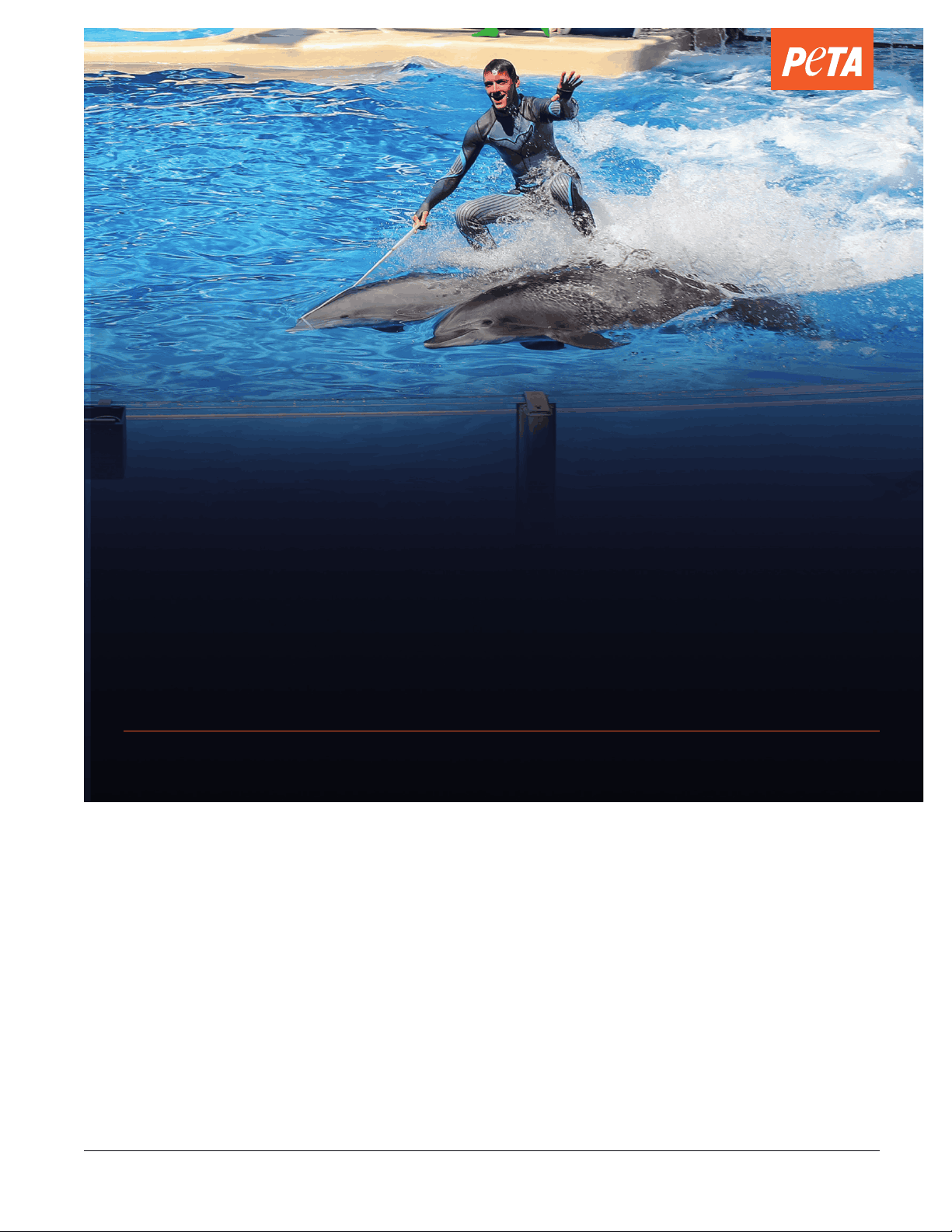
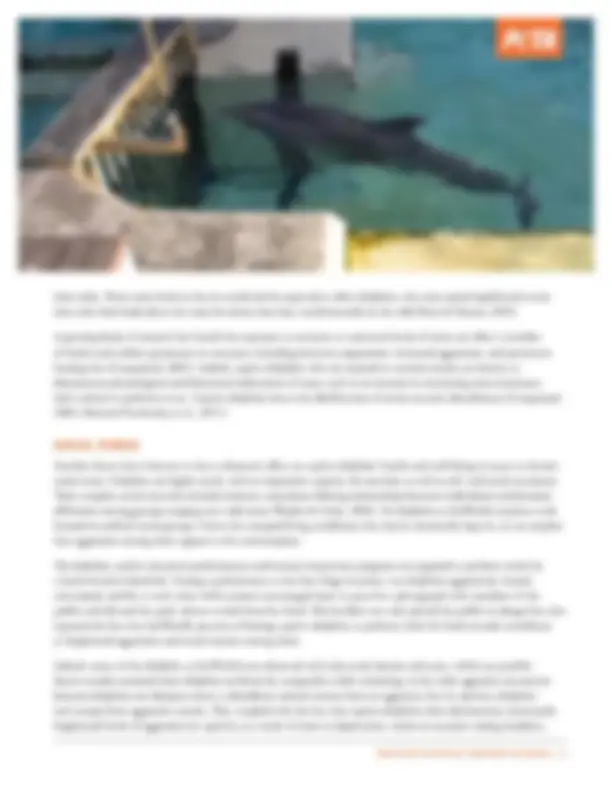
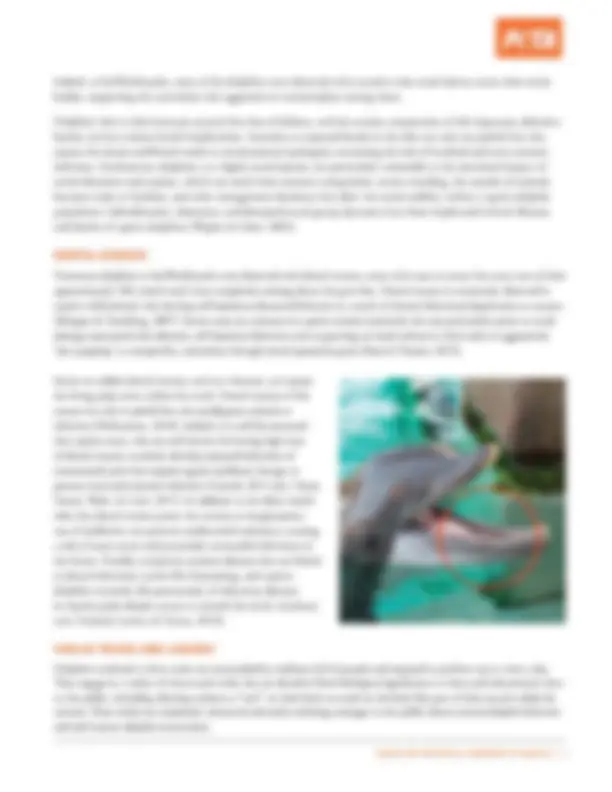
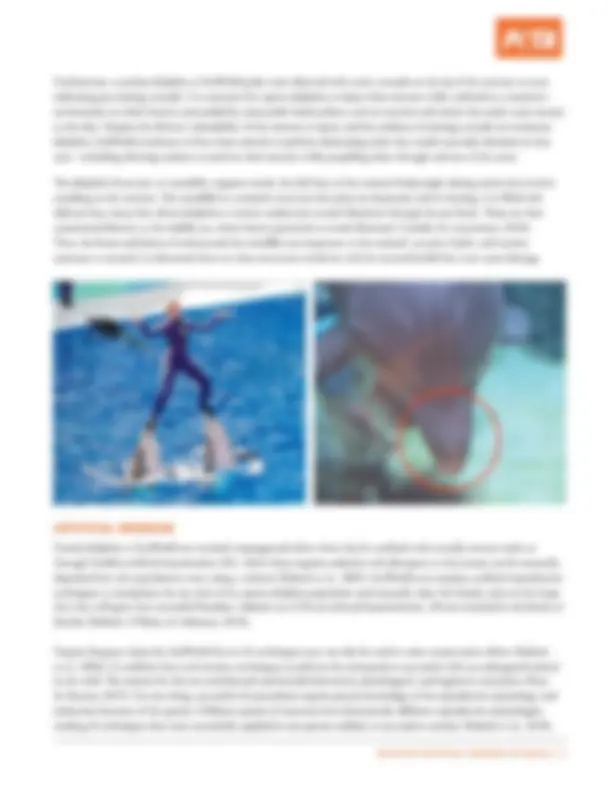
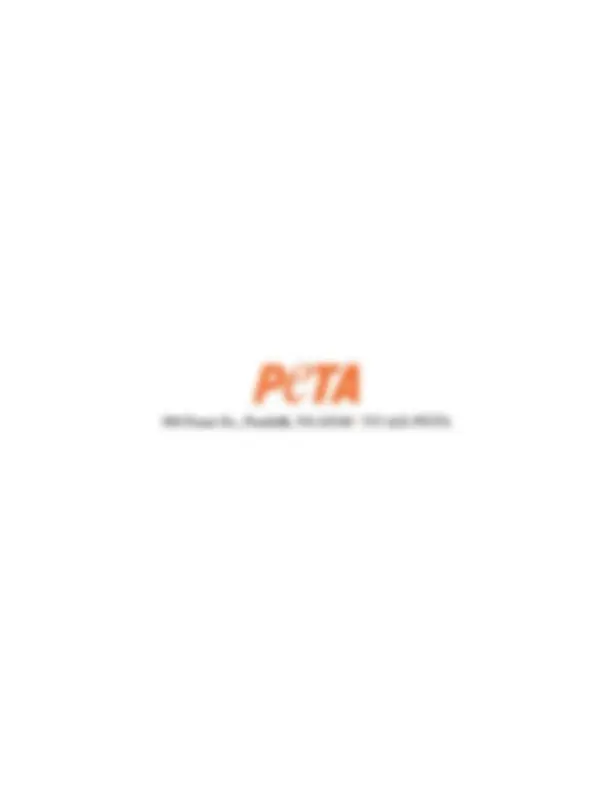


Study with the several resources on Docsity

Earn points by helping other students or get them with a premium plan


Prepare for your exams
Study with the several resources on Docsity

Earn points to download
Earn points by helping other students or get them with a premium plan
Community
Ask the community for help and clear up your study doubts
Discover the best universities in your country according to Docsity users
Free resources
Download our free guides on studying techniques, anxiety management strategies, and thesis advice from Docsity tutors
A critical analysis of the living conditions and welfare of dolphins at SeaWorld, highlighting issues related to confinement size, acoustic stress, social stress, dental disease, and artificial breeding. The document also advocates for the retirement of dolphins to seaside sanctuaries.
What you will learn
Typology: Study Guides, Projects, Research
1 / 8

This page cannot be seen from the preview
Don't miss anything!





In 2016, SeaWorld announced that it would end its orca-breeding program after facing mounting criticism from scientists and the public over its poor treatment of captive orcas (Howard, 2016). Since this announcement, however, the company has continued to breed bottlenose and Pacific white-sided dolphins—the orca’s smaller cousins—and house them in small, concrete tanks, as well as exploiting them in archaic, circus-style performances and interactive programs in which they’re touched, grabbed, and stood on by trainers. In November 2018, a veterinarian observed the captive dolphins held at the SeaWorld parks in San Diego, San Antonio, and Orlando. Evidence obtained from those observations revealed that the well-being of captive dolphins at the parks is severely compromised by the conditions in which they’re forced to live. This includes an astonishing number of dolphins—140—confined to just seven tanks at four SeaWorld–owned theme parks in the Unites States.i^ This report provides a glimpse into the miserable lives of these exploited animals, who endure routine physical, psychological, and social stress and at times sustain painful injuries as a result. © dreamstime.com/Paul Brewster
Captive dolphins at SeaWorld are housed in severely crowded, extremely shallow, small enclosures that are spatially, acoustically, and visually unnatural to the species. Most have barren concrete walls with bright, reflective surfaces that prioritize maximum visibility and accessibility of dolphins for park visitors over consideration of the animals’ health and welfare. For example, in SeaWorld’s shallow petting pools, members of the public are permitted direct access to the edge of the pool and are frequently observed harassing the dolphins by splashing and submerging their arms and hands in an attempt to grab and touch the animals. The tanks are devoid of sufficient depth and any natural features, hiding places, or variability that would allow the dolphins to take refuge from conspecifics or the public, creating an environment of inescapable, routine stress (Frohoff & Bekoff, 2018). Confining captive wild animals to small, barren, crowded enclosures causes them physical harm and trauma and can lead to illness and premature death. Studies have shown that far-ranging carnivores, such as dolphins, who would routinely travel long distances in nature, are acutely susceptible to suffering when confined to enclosures—like those at SeaWorld—that are just a minuscule fraction of the size of their natural home range (Clubb & Mason, 2003). An extremely small tank at SeaWorld Orlando labeled the “Dolphin Nursery” held at least 11 full-grown adult bottlenose dolphins. This tank, which is shallow in order to maximize visibility of the animals for park visitors, contains less than one third of the water that an Olympic-sized swimming pool does. Such a space isn’t adequate to house a single adult bottlenose dolphin, let alone nearly a dozen of these deep-diving, far-ranging, socially complex mammals. Whether caught in the wild or bred in captivity, dolphins are wild animals who are biologically driven and highly motivated to engage in specific natural behavior that helps them thrive in the ocean. This behavior includes swimming distances of up to 60 miles per day, diving to depths of nearly 1,500 feet, and maintaining dynamic relationships within a large social network (Klatsky, Wells, & Sweeney, 2007; Mann, Connor, Tyack, & Whitehead, 2000). Yet dolphins at SeaWorld are confined to constrained and injurious environments that are lacking in natural variability, treated with chemicals, and physically restrictive, with depths that are often only marginally greater than the legally required minimum of 6 feet (USDA, 2017), which is wholly inadequate and less than the length of their own bodies. ACOUSTIC STRESS Dolphins at SeaWorld parks are housed in conditions that exacerbate the impact of unnatural and anthropogenic noise on them. Acoustic stress is a serious welfare concern for captive dolphins, who would use their sophisticated acoustic systems to communicate, navigate, hunt, and visualize their environment in the wild with astonishing acuity. Their aural anatomy and physiology is highly complex and exceptionally sensitive to sources of sound and vibration. The dolphin tanks at SeaWorld parks—with their parallel concrete walls, metal gates and latches, and mechanical filtration plants and pumps—create an environment that potentiates anthropogenic noise, vibrations, and reverberations from both inside and outside the tank (Couquiaud, 2005). Additionally, at SeaWorld, dolphins are typically confined either to petting pools, in which they’re forced to interact with park visitors, or to performance pools, in which they’re forced to perform for audiences, both of which present unique noise insults. Park visitors have been observed tapping, knocking, and even banging on underwater-viewing tank glass at SeaWorld’s dolphin petting pools in an attempt to attract the animals’ attention. Because of the physical properties of sound propagation in water, such seemingly innocuous behavior can translate into intrusive noise that routinely assaults the animals’ hearing inside the tanks, creating an acoustic insult that is likely to cause chronic stress. Dolphins in shows were also routinely exposed to large, raucous crowds and loud, amplified music projected from speakers surrounding
Indeed, at SeaWorld parks, some of the dolphins were observed with extensive rake mark lesions across their entire bodies, supporting the conclusion that aggression is commonplace among them. Dolphins’ skin is their immune system’s first line of defense, and the routine compromise of this important defensive barrier can have serious health implications. Extensive or repeated breaks in the skin not only are painful but also expose the tissues and blood vessels to environmental pathogens, increasing the risk of localized and even systemic infection. Furthermore, dolphins, as a highly social species, are particularly vulnerable to the emotional impact of social alienation and tension, which can result from resource competition, severe crowding, the transfer of animals between tanks or facilities, and other management decisions that affect the social stability within a captive dolphin population. Subordination, alienation, and disrupted social group dynamics have been implicated in both illnesses and deaths of captive dolphins (Waples & Gales, 2002). DENTAL DISEASE Numerous dolphins at SeaWorld parks were observed with dental trauma, some with cases so severe that every one of their approximately 100 conical teeth were completely missing above the gum line. Dental trauma is commonly observed in captive wild animals who develop self-injurious abnormal behavior as a result of chronic behavioral deprivation or trauma (Morgan & Tromborg, 2007). Severe cases are common in captive marine mammals who are particularly prone to tooth damage associated with aberrant, self-injurious behavior such as gnawing on hard surfaces in their tanks or aggressively “jaw popping” at conspecifics, sometimes through metal separation gates (Rose & Parsons, 2019). Severe or sudden dental trauma, such as a fracture, can expose the living pulp cavity within the tooth. Dental trauma of this nature not only is painful but also predisposes animals to infection (Holmstrom, 2018). Indeed, it is well documented that captive orcas, who are well known for having high rates of dental trauma, routinely develop repeated infections of traumatized teeth that require regular antibiotic therapy to prevent local and systemic infection (Cornell, 2011; Jett, Visser, Ventre, Waltz, & Loch, 2017). In addition to the direct health risks that dental trauma poses, the routine or inappropriate use of antibiotics can promote antibacterial resistance, creating a risk of more severe and potentially untreatable infections in the future. Notably, numerous systemic diseases that are linked to dental infections can be life-threatening, and captive dolphins routinely die prematurely of infectious diseases in marine parks despite access to around-the-clock veterinary care (Tryland, Larsen, & Nymo, 2018). CIRCUS TRICKS AND LESIONS Dolphins confined to show tanks are surrounded by stadiums full of people and required to perform up to twice a day. They engage in a variety of circus-style tricks that are devoid of both biological significance to them and educational value to the public, including allowing trainers to “surf ” on their back or stand on the beak-like part of their mouth called the rostrum. These tricks are completely unnatural and send confusing messages to the public about normal dolphin behavior and safe human-dolphin interactions.
Furthermore, countless dolphins at SeaWorld parks were observed with active wounds on the tip of the rostrum or scars indicating pre-existing wounds. It is common for captive dolphins to injure their rostrum while confined to a restrictive environment in which they’re surrounded by unnaturally hard surfaces, such as concrete and metal, that easily cause trauma to the skin. Despite the obvious vulnerability of the rostrum to injury and the evidence of existing wounds on numerous dolphins, SeaWorld continues to force these animals to perform demeaning tricks that could cause skin abrasions in that area—including allowing trainers to stand on their rostrum while propelling them through and out of the water. The dolphin’s lower jaw, or mandible , supports nearly the full force of the trainer’s bodyweight during tricks that involve standing on the rostrum. The mandible is a sensitive structure that plays an important role in hearing. It is filled with delicate fatty tissue that allows dolphins to receive underwater sound vibrations through the jaw bone. These are then transmitted directly to the middle ear, where they’re perceived as sound (Rommel, Costidis, & Lowenstine, 2018). Thus, the bones and joints of and around the mandible are important to the animals’ acoustic health, and routine exposure to excessive or abnormal force on these structures could not only be uncomfortable but even cause damage. ARTIFICIAL BREEDING Female dolphins at SeaWorld are routinely impregnated either when they’re confined with sexually mature males or through forcible artificial insemination (AI), which often requires sedation with diazepam so that semen can be manually deposited into the reproductive tract using a catheter (Robeck et al., 2005). SeaWorld even employs artificial reproductive techniques to manipulate the sex ratio of its captive dolphin population and manually select for female calves in the hope that they will grow into successful breeders. Indeed, out of 30 sex-selected inseminations, 28 have resulted in the births of females (Robeck, O'Brian, & Atkinson, 2018). Despite frequent claims by SeaWorld that its AI techniques may one day be used to assist conservation efforts (Robeck et al., 2004), it’s unlikely that such invasive techniques would ever be attempted or successful with an endangered animal in the wild. The reasons for this are multifaceted and include behavioral, physiological, and logistical constraints (Rose & Parsons, 2019). For one thing, successful AI procedures require precise knowledge of the reproductive physiology and endocrine function of the species. Different species of cetaceans have dramatically different reproductive physiologies, making AI techniques that were successfully applied in one species unlikely to succeed in another (Robeck et al., 2018). © dreamstime.com/Izanbar
Clubb, R., & Mason, G. J. (2003). Animal welfare: captivity effects on wide-ranging carnivores. Nature , 425 , 473-474. doi:10.1038/425473a Couquiaud, L. (2005). Special Issue: Survey of cetaceans in captive care. Aquatic Mammals , 31 (3), 277-385. doi:10.1578/AM.31.3.2005. Frohoff, T., & Bekoff, M. (2018). Ethics: Marine Mammals. In B. Würsig, J.G.M. Thewissen, & K.M. Kovacs (Eds.), Encyclopedia of Marine Mammals, 3rd Edition (pp. 338-344). Cambridge, Massachusetts: Academic Press. Holmstrom, S. (2018). Dentistry. In F. M. D. Gulland, L. Dierauf, & K. L. Whitman (Eds.), CRC Handbook of Marine Mammal Medicine, 3rd Edition (pp. 501-517). New York, New York: CRC Press. Howard, B. C. (2016). SeaWorld to End Controversial Orca Shows and Breeding: The entertainment company has yielded to intense pressure from animal activists. National Geographic. Jett, J., Visser, I. N., Ventre, J., Waltz, J., & Loch, C. (2017). Tooth damage in captive orcas (Orcinus orca). Archives of Oral Biology, 84 , 151-160. doi:10.1016/j. archoralbio.2017.09. Klatsky, L. J., Wells, R. S., & Sweeney, J. C. (2007). Offshore Bottlenose Dolphins ( Tursiops truncatus ): Movement and Dive Behavior Near the Bermuda Pedestal. Journal of Mammalogy, 88 (1), 59-66. doi:http://dx.doi.org/10.1644/05-MAMM-A-365R1. Mann, J., Connor, R. C., Tyack, P. L., & Whitehead, H. (Eds.). (2000). Cetacean Societies: Field Studies of Dolphins and Whales (First ed.). Chicago: University of Chicago Press. Monreal-Pawlowsky, T., Carbajal, A., Tallo-Parra, O., Sabés-Alsina, M., Monclús, L., Almunia, J.,... Lopez-Bejar, M. (2017). Daily salivary cortisol levels in response to stress factors in captive common bottlenose dolphins ( Tursiops truncatus ): a potential welfare indicator. Veterinary Record, 0.1136/vr.103854, 1-3. Morgan, K. N., & Tromborg, C. T. (2007). Sources of stress in captivity. Applied Animal Behaviour Science, 102, 262-302. doi:10.1016/j.applanim.2006.05. Robeck, T. R., O'Brian, J. K., & Atkinson, S. (2018). Reproduction. In F. M. D. Gulland, L. Dierauf, & K. L. Whitman (Eds.), CRC Handbook of Marine Mammal Medicine, 3rd Edition (pp. 169-209). New York, New York: CRC Press. Robeck, T. R., Steinman, K. J., Gearhart, S., Reidarson, T. R., McBain, J. F., & Monfort, S. L. (2004). Reproductive physiology and development of artificial insemination technology in killer whales (Orcinus orca). Biology of Reproduction, 71 , 650-660. doi:10.1095/biolreprod.104. Robeck, T. R., Steinman, K. J., Yoshioka, M., Jensen, E., O'Brien, J. K., Katsumata, E.,... Monfort, S. L. (2005). Estrous cycle characterization and artificial insemination using frozen-thawed spermatozoa in the bottlenose dolphin (Tursiops truncatus). Reproduction, 129 , 659-674. doi:10.1530/rep.1. Rojas-Bracho, L., Gulland, F. M. D., Smith, C. R., Taylor, B., Wells, R. S., Thomas, P. O.,... Walker, S. (2019). A field effort to capture critically endangered vaquitas Phocoena sinus for protection from entanglement in illegal gillnets. Endangered Species Research, 38 , 11-27. doi:https://doi.org/10.3354/esr Rommel, S. A., Costidis, A. M., & Lowenstine, L. J. (2018). Gross and Microscopic Anatomy. In F. M. D. Gulland, L. Dierauf, & K. L. Whitman (Eds.), CRC Handbook of Marine Mammal Medicine, 3rd Edition (pp. 89-136). New York, New York: CRC Press. Rose, N. A., & Parsons, E. C. M. (2019). The Case Against Marine Mammals in Captivity, 5th Edition (pp. 1-160). Washington D.C.: Animal Welfare Institute and World Animal Protection. Retrieved from https://awionline.org/sites/default/files/uploads/documents/AWI-ML-CAMMIC-5th-edition.pdf SeaWorld Parks & Entertainment LLC v. Marineland of Canada Inc., 2011, ONSC 4084, No. 5278311 (Cornell Aff. ¶ 000059). Tryland, M., Larsen, A. K., & Nymo, I. H. (2018). Bacterial Infections and Diseases. In F. M. D. Gulland, L. Dierauf, & K. L. Whitman (Eds.), CRC Handbook of Marine Mammal Medicine, 3rd Edition (pp. 367-389). New York, New York: CRC Press. USDA. (2017). Animal Welfare Act and Animal Welfare Regulations: Title 7, Agriculture. Chapter 54, Transportation, Sale, and Handling of Certain Animals. Subpart E, Specifications for the Humane Handling, Care, Treatment, and Transportation of Marine Mammals. Section 3.104. 196-209. Waples, K. A., & Gales, N. J. (2002). Evaluating and minimising social stress in the care of captive bottlenose dolpins ( Tursiops aduncus ). Zoo Biology, 21 , 5-26. doi:10.1002/zoo. iInventory includes dolphins at SeaWorld Orlando, SeaWorld San Diego, SeaWorld San Antonio, and Discovery Cove Orlando from Ceta Base: Captive Cetacean Database. “Cetacean Database: Living Population, All Species.” Accessed 11 February 2019. www.ceta-base.org.